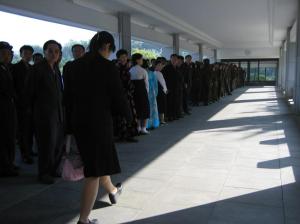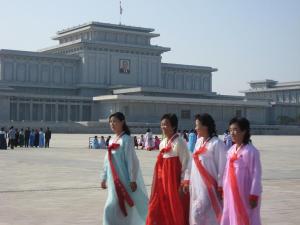August 23, 2009
From August 23, 2009
In October 2008, I traveled to North Korea. Before our departure, our group was informed that we marked roughly the 1,000th U.S. citizen to visit North Korea since the Korean War, over 58 years ago. In the wake of former President Clinton’s surprise visit to Pyongyang, to retrieve two imprisoned U.S. journalists, many people have asked me about my trip. Over the next several weeks, in a series of posts, I will relate some of my experiences and impressions from this journey.

Many Americans are under the incorrect impression that it is illegal for them to travel to North Korea, much like Cuba. While the U.S. does place a strict cap ($100) on how many souvenirs you can buy and bring home, as part of its commercial sanctions, the main obstacle to travel stems from the North Korean side, which grants only a handful of visas to U.S. citizens each year to view the Mass Games. Regardless, I realize that many people still have strong moral objections to traveling to North Korea (also known as the Democratic People’s Republic of Korea, or DPRK). I understand and actually share many of those objections. There were some aspects of the trip that I found upsetting or uncomfortable, as I will explain. But I felt that these objections and discomforts were outweighed by the unique opportunity to gather first-hand knowledge and insight into a country few Americans have ever seen. Keep in mind, as you read, that I have sometimes muted opinions or omitted details that might put others, particularly any North Koreans we interacted with, at risk. The intelligent reader will be able to read between the lines.
When you visit North Korea, they tell you all the things you’re going to see, but they don’t let you know until the very last minute — usually when you get on the bus — exactly when you’re going to go see them. The idea, I imagine, is to prevent you from arranging to meet up with someone at a pre-determined time and place — which would be a pretty astonishing feat even with a fixed itinerary. The tour group is always together, under the supervision of one guide and two friendly but alert minders. No laptops or cell phones are allowed into the country. You must ask permission before taking any photograph. You must not stray more than a few yards from the group at any moment, and when the sightseeing schedule for the day is over, you are essentially confined to the hotel.
The centerpiece of all tours, which I’ll focus on today, is the mandatory visit to the mausoleum of Kim Il-Sung, who founded the DPRK with Stalin’s backing, launched the Korean War, and eventually bequeathed his reign to his son Kim Jong-Il, the country’s current ruler. They tell you about it the night before, because you have to wear a collared shirt and tie, along with nice shoes and pants. The visit is a very big deal as far as the North Koreans are concerned, and the guides are all riding on pins and needles to make sure the proper courtesies are observed. Kim Il-Sung, the “Great Leader,” is regarded as a virtual god among men, the pinnacle of human perfection in all respects, and his mausoleum is actually a vast Versailles-like palace complex on the outskirts of Pyongyang. It makes Mao’s tomb in Beijing, or Lenin’s in Moscow, seem like mere hovels by comparison.

When we arrived at the marble entrance pavilion, we were whisked past a long line of North Koreans waiting to enter by work unit. We were told, later, that each work unit in the entire country pays two visits to the mausoleum every year. I can’t confirm whether that is true, but we did hear it separately from multiple sources. And given the resources devoted to performing the Mass Games, and the central role the elder Kim’s cult of personality plays in underpinning the regime, I can easily believe it. As one of our foreign guides explained, Kim’s tomb is the most sacred site in all of North Korea, a kind of Vatican, Mecca, and Temple Mount all rolled into one.
Just past the doors, we passed through a security check with metal detectors and handed over our cameras, which were strictly prohibited beyond this point. In complete silence, we descended an escalator and stepped foot onto a series of moving walkways — like the ones at airports — that carried us through a long narrow corridor, several football fields in length. A parallel walkway, to our right, carried work units of North Koreans who had just completed their visit slowly past us in the opposite direction, also in total silence. Each of their faces, as they passed, followed us with looks of fear, revulsion, and hostility such as I have never seen. Unnerved, we giggled uncomfortably to each other and tried to avoid their unrelenting stares.
Finally we reached the end of this ordeal and entered a large marble foyer. We were instructed to form up, platoon-style, in front of a massive door. The North Koreans are well practiced lining up for everything, but among the Americans I was probably the only one who had ever done this before in the army, so we shuffled back and forth in disarray for a while as our hosts shook their heads, unimpressed. Then the doors swung open and we marched into a large hall where, at the far end, a great statue of Kim Il-Sung, about 30 feet tall in the purest white marble, stood facing us. On a screen behind it, the warm pink glow of a sunrise was just beginning to emerge below a clear blue sky.
There are moments in life when you are reduced to silence. It could be the moment your bride walks down the aisle, or when you hold your firstborn child in your arms, or when you witness death up close. Time stops, and you cross an invisible boundary where you confront something so fundamental that it escapes either word or thought. And that moment stays with you forever, coloring all that you are.
For me, walking across that hall, seeing that statue loom larger and larger, with that sunrise behind it, was one of those moments. It sounds trite to say that it reminded me of Big Brother in 1984, that I felt I had walked into the pages of that novel, except this was real. It sounds clichéd to say it made me appreciate being born in a free country or made me realize, for a moment, what it might have been like not to be. But that statue and that hallway conveyed something very simple, a feeling I will never forget: I am big and you are small. I am powerful and you are nothing. And the worst part was knowing that, at that moment, it was true.
There was a popular and very influential TV ad by Apple Computer, a take-off of 1984, where a lone renegade enters a great assembly hall presided over by an image of Big Brother, and heaves a giant hammer that destroys it. Obama supporters even parodied the ad last year, in a dig at Hillary Clinton. It’s a romantic notion, one that could only be entertained in a free society. In that room, beneath that smiling statue, it became painfully obvious how inconceivable and futile such an act of defiance would be, in real life. What if this were the only reality I knew? What if the consequences of even thinking, even imagining something different would be devastating, for me and my whole family? This place was no book. It was no ad. It was no joke. What if this were my life and I couldn’t just walk out of here and fly back home?
With these thoughts half-formed in my mind, we were ushered out the side and into another room where we were handed little MP3 players with earphones. On either side of the room were carved reliefs depicting both Koreans and foreigners weeping inconsolably, tearing their hair, and beating their breasts in grief. The voice in the earphone intoned in the most Shakespearian style of oratory how people all over the world broke down in tears when they heard on July 8, 1994 the news that the great Kim Il-Sung had died. Could it possibly be? How could they go on? What more was there to live for? Would anyone smile or laugh ever again?
At some point during all this we were pressed one by one through a narrow metal doorway which shot concentrated poofs of air at us as we passed. We were told that it was to remove any dust, sort of a “cleansing ritual” before seeing the Great Leader himself, but at this point the mind could hardly keep from imagining something more bizarre and sinister.
At long last, we entered a great red chamber where Kim Il-Sung himself lay in state. At least it looked like Kim, waxily preserved for posterity. All around him Koreans — especially older Korean women in traditional robes — were sobbing in tears. The entire room buzzed with an emotional energy that certainly seemed heartfelt. Each group proceeded around the open casket, lining up and bowing three times, once on the side, once at the head, and again on the other side.
I had been warned, before signing up for the tour, that we would be expected to bow at this point. I found the idea distasteful in the extreme, but had been assured that bowing, to the Koreans, was seen not as a sign of submission or obeisance, but simple politeness. And it was non-negotiable. To not bow would be deeply offensive. It was, if you like, the price of admission.

Now the moment was upon us. As we lined up to take our turn, I thought about our soldiers back in 1950, fighting to hold the Pusan Perimeter, or desperate and freezing along the Chosin Reservoir — the same men I had seen puttering around American Legion posts back home, or honored in bronze on the Washington Mall. How could I ever look them in the face? I thought about the needless destruction, and the orphans, and the nightmare that was still happening all around me. I tried to bow, out of sheer politeness, I really did. But my stomach clenched and my waist just wouldn’t bend. The moment passed, and I looked around in a panic, terrified that someone would be furious, but everyone seemed too preoccupied to notice. I performed the same half-twitch at each station and moved on, feeling depressed and drained.
Somehow we ended up on the same moving walkway, carrying us back down the long corridor towards the exit. Except that now the tension had burst, and we were chattering openly with each other, barely noticing the endless parade of hostile stares from North Koreans passing us on the way in.
We retrieved our cameras, and were taken outside to take pictures in front of the palace. There the mood of the North Koreans we encountered changed completely. They laughed and waved, even posed for us, like holiday-makers out strolling in their Sunday best. No longer in the immediate presence of the Great Leader, the tension had suddenly dissipated for them as well, and they had resumed their role as regular human beings. It was one of the precious few chances we had to interact with everyday North Koreans in a relatively unconstrained setting.
Next installment: The bizarre world of our hotel and Pyongyang’s secret nightlife.
All photos were taken by the author. Please ask permission before copying.
[…] response to Part 1 of my story, many readers were curious to know what the North Koreans we encountered were really thinking […]